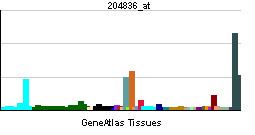Entrez 2731 | Ensembl ENSG00000178445 | |
 | ||
External IDs MGI: 1341155 HomoloGene: 141 GeneCards: GLDC | ||
Glycine decarboxylase also known as glycine cleavage system P protein or glycine dehydrogenase is an enzyme that in humans is encoded by the GLDC gene.
Contents
Reaction
Glycine decarboxylase (EC 1.4.4.2) is an enzyme that catalyzes the following chemical reaction:
glycine + H-protein-lipoyllysineThus, the two substrates of this enzyme are glycine and H-protein-lipoyllysine, whereas its two products are H-protein-S-aminomethyldihydrolipoyllysine and CO2.
This enzyme belongs to the family of oxidoreductases, specifically those acting on the CH-NH2 group of donors with a disulfide as acceptor. This enzyme participates in glycine, serine and threonine metabolism. It employs one cofactor, pyridoxal phosphate.
Function
Glycine decarboxylase is the P-protein of the glycine cleavage system in eukaryotes. The glycine cleavage system catalyzes the degradation of glycine. The P protein binds the alpha-amino group of glycine through its pyridoxal phosphate cofactor. Carbon dioxide is released and the remaining methylamine moiety is then transferred to the lipoamide cofactor of the H protein.
Degradation of glycine is brought about by the glycine cleavage system, which is composed of four mitochondrial protein components: P protein (a pyridoxal phosphate-dependent glycine decarboxylase), H protein (a lipoic acid-containing protein), T protein (a tetrahydrofolate-requiring enzyme), and L protein (a lipoamide dehydrogenase).
Clinical significance
Glycine encephalopathy may be due to a defect in GLDC or AMT of the glycine cleavage system.
